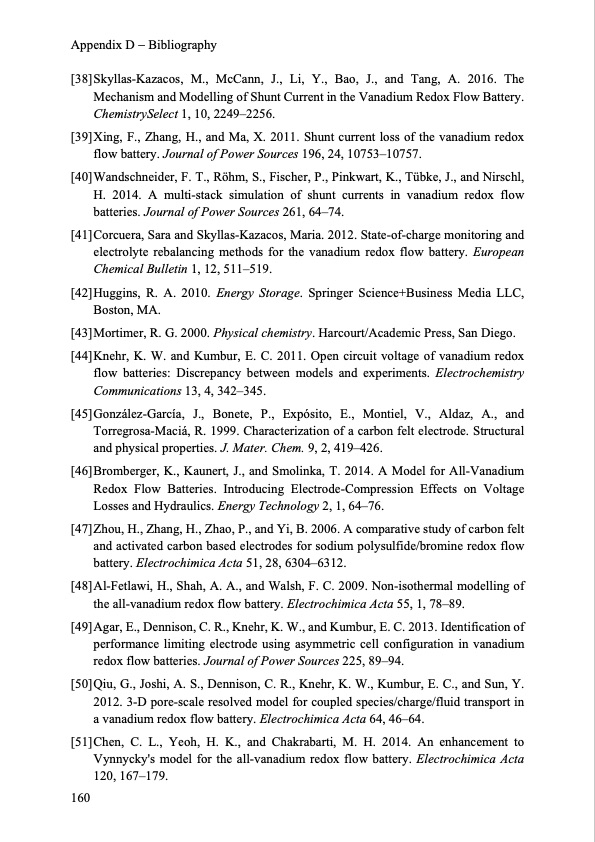
PDF Publication Title:
Text from PDF Page: 168
Appendix D Bibliography [38]Skyllas-Kazacos, M., McCann, J., Li, Y., Bao, J., and Tang, A. 2016. The Mechanism and Modelling of Shunt Current in the Vanadium Redox Flow Battery. ChemistrySelect 1, 10, 2249–2256. [39]Xing, F., Zhang, H., and Ma, X. 2011. Shunt current loss of the vanadium redox flow battery. Journal of Power Sources 196, 24, 10753–10757. [40]Wandschneider, F. T., Röhm, S., Fischer, P., Pinkwart, K., Tübke, J., and Nirschl, H. 2014. A multi-stack simulation of shunt currents in vanadium redox flow batteries. Journal of Power Sources 261, 64–74. [41]Corcuera, Sara and Skyllas-Kazacos, Maria. 2012. State-of-charge monitoring and electrolyte rebalancing methods for the vanadium redox flow battery. European Chemical Bulletin 1, 12, 511–519. [42]Huggins, R. A. 2010. Energy Storage. Springer Science+Business Media LLC, Boston, MA. [43]Mortimer, R. G. 2000. Physical chemistry. Harcourt/Academic Press, San Diego. [44]Knehr, K. W. and Kumbur, E. C. 2011. Open circuit voltage of vanadium redox flow batteries: Discrepancy between models and experiments. Electrochemistry Communications 13, 4, 342–345. [45]González-García, J., Bonete, P., Expósito, E., Montiel, V., Aldaz, A., and Torregrosa-Maciá, R. 1999. Characterization of a carbon felt electrode. Structural and physical properties. J. Mater. Chem. 9, 2, 419–426. [46]Bromberger, K., Kaunert, J., and Smolinka, T. 2014. A Model for All-Vanadium Redox Flow Batteries. Introducing Electrode-Compression Effects on Voltage Losses and Hydraulics. Energy Technology 2, 1, 64–76. [47]Zhou, H., Zhang, H., Zhao, P., and Yi, B. 2006. A comparative study of carbon felt and activated carbon based electrodes for sodium polysulfide/bromine redox flow battery. Electrochimica Acta 51, 28, 6304–6312. [48]Al-Fetlawi, H., Shah, A. A., and Walsh, F. C. 2009. Non-isothermal modelling of the all-vanadium redox flow battery. Electrochimica Acta 55, 1, 78–89. [49]Agar, E., Dennison, C. R., Knehr, K. W., and Kumbur, E. C. 2013. Identification of performance limiting electrode using asymmetric cell configuration in vanadium redox flow batteries. Journal of Power Sources 225, 89–94. [50]Qiu, G., Joshi, A. S., Dennison, C. R., Knehr, K. W., Kumbur, E. C., and Sun, Y. 2012. 3-D pore-scale resolved model for coupled species/charge/fluid transport in a vanadium redox flow battery. Electrochimica Acta 64, 46–64. [51]Chen, C. L., Yeoh, H. K., and Chakrabarti, M. H. 2014. An enhancement to Vynnycky's model for the all-vanadium redox flow battery. Electrochimica Acta 120, 167–179. 160PDF Image | Model-based Design Vanadium Redox Flow Batteries

PDF Search Title:
Model-based Design Vanadium Redox Flow BatteriesOriginal File Name Searched:
10-5445IR1000070670.pdfDIY PDF Search: Google It | Yahoo | Bing
Salgenx Redox Flow Battery Technology: Salt water flow battery technology with low cost and great energy density that can be used for power storage and thermal storage. Let us de-risk your production using our license. Our aqueous flow battery is less cost than Tesla Megapack and available faster. Redox flow battery. No membrane needed like with Vanadium, or Bromine. Salgenx flow battery
| CONTACT TEL: 608-238-6001 Email: greg@salgenx.com | RSS | AMP |